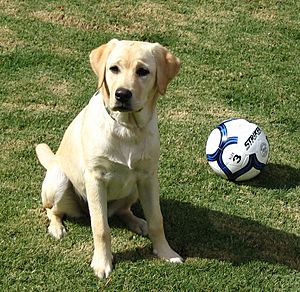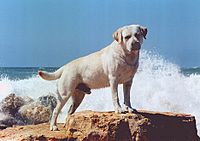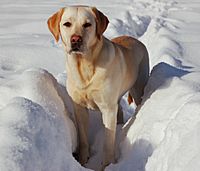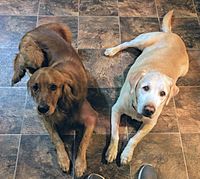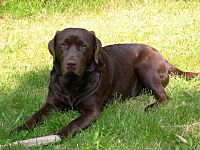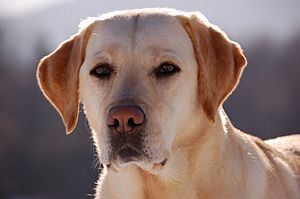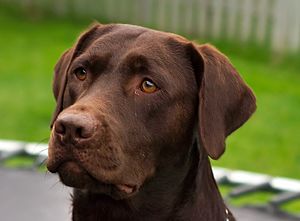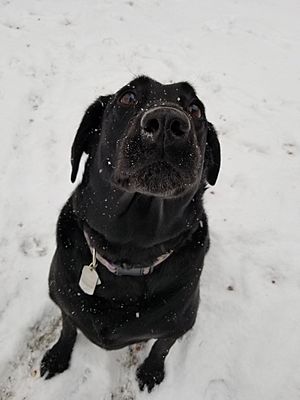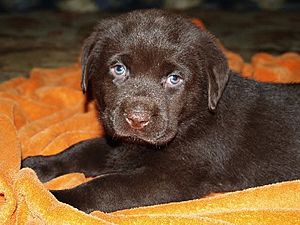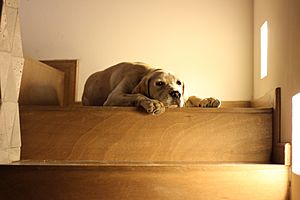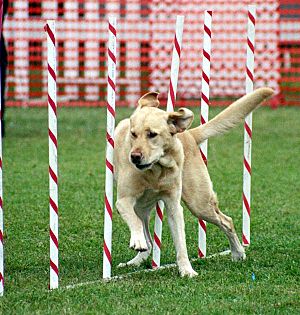Labrador Retriever facts for kids
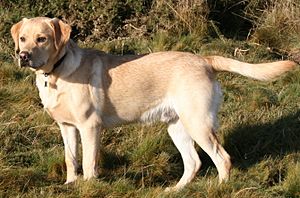 |
|||||||||||||||||||||||||||||
| Other names | Labrador | ||||||||||||||||||||||||||||
|---|---|---|---|---|---|---|---|---|---|---|---|---|---|---|---|---|---|---|---|---|---|---|---|---|---|---|---|---|---|
| Common nicknames | Lab | ||||||||||||||||||||||||||||
| Origin | United Kingdom | ||||||||||||||||||||||||||||
| Foundation stock | St. John's water dog | ||||||||||||||||||||||||||||
|
|||||||||||||||||||||||||||||
|
|||||||||||||||||||||||||||||
| Domestic dog (Canis lupus familiaris) | |||||||||||||||||||||||||||||
The Labrador Retriever is a popular type of dog. People often call them Labs or Labradors for short. They are known as gun dogs, which means they were originally bred to help hunters. Labradors are very gentle and have friendly personalities, making them great family pets. They are the most popular dog breed in many countries, including Australia, Canada, New Zealand, the United Kingdom, and the United States.
Labs love to get attention and need lots of exercise with their owners. They enjoy running in open spaces and naturally love to fetch things. They are also excellent swimmers because their coats protect them from cold water. Their paws have webbing between the toes, which helps them swim even better! Labrador Retrievers have short, dense coats that come in three main colors: black, yellow, and brown.
This strong and playful breed is a wonderful choice for a family pet. They are usually easy to train and naturally follow commands. However, Labradors need daily exercise to stay healthy and can gain weight easily. They also love water and have a special "otter-like" tail. They use their tail like a rudder to steer when they swim.
Contents
History of Labradors
Labradors come from dogs that lived on the island of Newfoundland, in Canada. Their ancestor is the St. John's water dog. This breed developed in the 16th century from dogs brought by early settlers. These dogs were trained to pull fishing nets from the cold water for fishermen.
In the early 1800s, some of these dogs were brought to Poole in Great Britain. People were very impressed by them. These dogs had strong, short legs and were great swimmers. They had thick coats and broad tails. The Earl of Malmesbury was especially interested in these dogs. He started breeding them for duck hunting on his estate. He named this new breed of retrievers "Labrador."
Different Types of Labradors
Labrador Retrievers are often described in two ways: English Labs or American Labs. The main differences are in their behavior and how they look. English Labs are usually easier to train. They are often considered better for families or new dog owners. American Labs tend to have more energy. They were bred for dog competitions called field trials. This means they are better for owners with more experience and time for training.
When it comes to looks, English Labs often have the "blocky" heads that Labradors are famous for. American Labs are usually leaner and have longer legs. Yellow and chocolate colored puppies used to be rare. Sometimes they were even removed from litters. But in the 20th century, these colors became accepted. The first recognized Yellow Labrador was Ben of Hyde, born in 1899. Chocolate Labradors became more common in the 1930s.
Yellow and Fox Red Labradors
In the early days, "yellow" Labradors were actually a dark, butterscotch color. This color was called "Golden." The UK Kennel Club later asked for the name to be changed because "Gold" is not a true color. Over time, lighter shades of yellow and cream became more popular. Today, most yellow Labradors are a very light color. Fawn has also been a common shade in yellow Labs.
In the 1980s, English breeders became interested in darker shades again, like fox red. Three dogs were very important in bringing back these colors. Balrion King Frost (a black Lab born around 1976) often had "very dark yellow" puppies. He helped bring back the fox red shade. His great-grandson, Wynfaul Tabasco (born 1986), is called "the father of the modern fox red Labrador." He was the only modern fox red Show Champion in the UK.
- Yellow Labradors
-
Golden Retrievers (left) are often confused with yellow Labs (right). One obvious difference is the much shorter hair of the Labrador.
Chocolate Labradors
Experts have traced all Chocolate Labradors back to eight original family lines. Before the 20th century, chocolate was not seen as a separate color. Dogs with this color were not officially registered. Some early 20th-century records show that Chocolate Labradors were sometimes bred with Flatcoats or Chesapeake Bay Retrievers. Chocolate Labradors were also well-known in the early 1900s at the kennels of the Earl of Feversham and Lady Ward.
The family lines of Chocolate Labradors can be traced back to three black Labradors from the 1880s. These were Buccleuch Avon, his father Malmesbury Tramp, and his mother Malmesbury June.
- Chocolate Labradors
What Labradors Look Like
Labradors are medium to large-sized dogs. Male Labs usually weigh between 65 and 80 pounds (29–36 kg). Females typically weigh between 55 and 70 pounds (25–32 kg). Most of their features, except for their color, were developed to make them good working retrievers.
There are two main types of Labradors: "Show" (or "English") and "Field" (or "American"). Show Labradors are usually shorter and stockier. They have fuller faces and are a bit calmer. Field Labradors are often taller and have lighter bodies. Their faces are less broad, and their noses are a bit longer. Both types are still considered true Labradors.
Labradors shed hair about twice a year, or regularly if they live in mild climates. Some Labs shed a lot. Their hair is usually short and straight. Their tail is wide and strong. The webbed toes of a Labrador make them amazing swimmers. This webbing also helps them walk in snow, like snowshoes. Their waterproof coat helps them stay warm in the water.
Official Breed Standards
There are many different looks among Labradors. The following features are typical for show-bred Labradors in the United States, based on the American Kennel Club (AKC) rules.
- Size: Labradors are a medium-large breed. They should be about as long as they are tall. The AKC says males should ideally weigh 65–80 pounds (29–36 kg) and females 55–70 pounds (25–32 kg).
- Coat: A Labrador's coat should be short and thick, but not rough. It is water-resistant, which keeps the dog warm in cold water. This means their coat is naturally a bit dry and oily. The accepted colors are black, yellow, and chocolate.
- Head: The head should be wide with slightly raised eyebrows. Their eyes should look kind and expressive. Eye colors can be brown or hazel. The skin around their eyes should be black. Their ears should hang close to their head, set a little above their eyes.
- Jaws: Their jaws should be strong. The muzzle should be medium in length and not too narrow.
- Body: The body should be strong and muscular.
The tail and coat are special features of the Labrador breed. The AKC also says that a true Labrador's friendly personality is just as important as its "otter" tail.
Coat Color Variations
Labrador Retrievers are officially registered in three colors: black (solid black), yellow (from cream to fox-red), and chocolate (medium to dark brown). Some dogs are sold as "silver" purebred Labradors. However, whether these silver dogs are truly purebred is debated by breed experts. Some major dog clubs allow silver Labradors to be registered, but not as "silver." For example, The Kennel Club in England requires them to be registered as "Non-recognised."
Sometimes, Labradors might have small white patches on their chest, paws, or tail. Very rarely, a purebred Lab might have stripes or tan markings, like a Rottweiler. These markings mean the dog cannot be shown in dog shows. But they do not affect the dog's personality or its ability to be a good pet or working dog.
Puppies of all three colors can be born in the same litter. The color is mainly decided by three genes. Other genes control the smaller details of the coat's color. For yellow Labradors, the color can range from white to light gold to fox red. Chocolate and black Labradors will have noses that match their coat color.
Nose and Skin Color
Labrador color is controlled by many genes. Sometimes, hidden genes can show up in later generations. Also, different parts of the body can have unexpected pigmentation effects. This is most common with yellow Labradors. The nose, lips, gums, feet, and eye rims are where you can see this color. They can be black, brown, light yellow-brown, or other colors. A Labrador can carry genes for a different color. For example, a black Labrador can carry genes for chocolate and yellow. DNA testing can help find these hidden genes.
Yellow Labradors usually have black noses. These noses might slowly turn pink with age. This is called "snow nose" or "winter nose." It happens because of a decrease in a chemical that helps make dark coloring. This chemical is affected by temperature, so nose color can change with the seasons. It also decreases as the dog gets older, usually after two years old.
A color called "Dudley" is also possible. Dudleys are yellow Labradors with pink noses and pink skin around their eyes. A yellow Labrador with a brown nose is not necessarily a Dudley. However, if it also has brown skin around its eyes, it might be considered a Dudley. True Dudleys are very rare. Having a true Dudley color is a fault in dog shows. This means such dogs are still allowed to be shown, but it is not ideal.
Labrador Temperament and Behavior
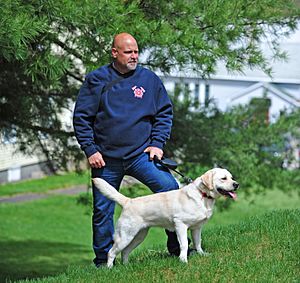
The AKC describes the Labrador's personality as kind, pleasant, friendly, and easy to manage. Labradors have an amazing sense of smell. They can follow almost any scent until they find its source. Because of this, navies, military, and police use them as detection dogs. They help find smugglers, thieves, and other things. They are also known for having a "soft mouth." This means they can gently carry things without damaging them, which was useful for retrieving birds for hunters. They do like to chew objects, but they can be trained not to.
Labradors are known for being very even-tempered and make excellent family dogs. They are usually good with children of all ages and other animals. Some Labs, especially those bred for working, are very fast and athletic. Their playful energy and lack of fear sometimes need training to keep under control. An untrained adult Lab can be quite a handful. Female Labs might be a bit more independent than males. Labradors grow up around three years old. Before that, they can have a lot of puppy-like energy. It's a good idea to train them early to walk nicely on a leash. Labradors often love to fetch a ball over and over again. They also enjoy other activities like dog agility, frisbee, or flyball.
Labradors might bark at noises, especially if they can't see where the sound comes from. But they are usually not noisy or protective of their space. They are often very friendly and trusting with strangers. This means they are not usually good guard dogs.
Labradors are curious and love to explore. They enjoy being with people and following interesting smells, especially for food. Because of this, they can sometimes wander off or get separated from their owners. They are very smart and can focus intensely if they are interested in something. A bored Labrador might become an "escape artist." Many Labs are also stolen. Because they are curious and can wander, many dog clubs suggest that Labradors should have a microchip. Owners should also put their name and address on their dog's collar and tags.
The calm nature of Labradors and their ability to learn make them perfect for search and rescue, detection, and therapy work. They are a very intelligent breed. They are ranked number 7 in Stanley Coren's The Intelligence of Dogs. The AKC says they are ideal family and sporting dogs. Their main job in the field is still to retrieve things for hunters.
Labradors as Working Dogs

Labradors are smart dogs with a good work ethic and generally calm personalities. They are often used for many jobs, including: hunting, tracking, detection (because of their great sense of smell), helping disabled people, carting, and therapy work. About 60–70% of all guide dogs in Canada are Labradors. Other common guide dog breeds are Golden Retrievers and German Shepherds.
Labrador Retrievers have a high success rate in becoming guide dogs. A study looked at how well four different breeds trained to be guide dogs. Labradors and Labrador/Golden Retriever mixes had the highest success rates.
Labradors are strong swimmers and can handle very cold water for a long time. They can work quietly with hunters, watching birds fall from the sky. They remember where the birds land and then use their amazing nose to find and bring back the birds. This makes them the best dogs for retrieving waterfowl. They are also used for pointing and flushing game, making them great partners for hunting in fields.
Labradors are very intelligent and can show great initiative in their jobs. For example, a dog named Endal saved a man in 2001. The man was unconscious. Endal put him in a safe position, got his mobile phone from under the car, found a blanket and covered him. Then, Endal barked for help and ran to a nearby hotel to get more assistance. Some Labradors have even been taught to help their owners get money and credit cards from ATMs.
The breed is also used in water rescue and lifesaving. They still do this job today, along with Leonbergers, Newfoundlands, and Golden Retrievers. They are used at the Italian School of Canine Lifeguard.
Related Pages
Images for kids
See also
 In Spanish: Labrador retriever para niños
In Spanish: Labrador retriever para niños


